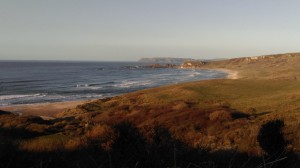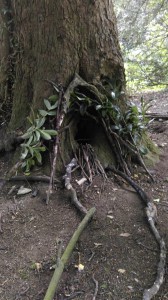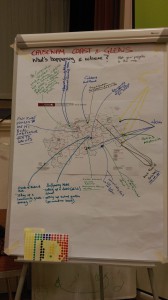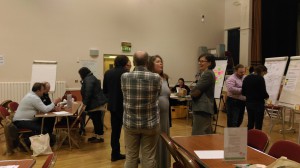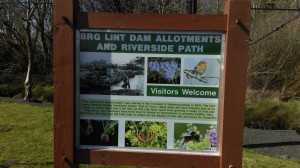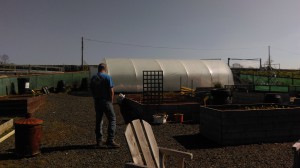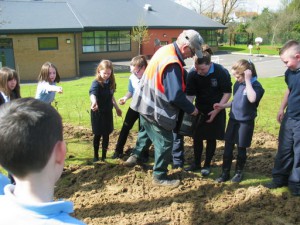
Hi guys! It’s been a while since I’ve written a post (it’s been very busy), so grab a cup of tea and a biscuit, it’s a bit of a long one! But first; after work one day I went down to Whitepark Bay on the coast for a bit of wandering and flower ID’ing – it’s such a lovely spot, I’m so lucky to live and work close by!
I’ve continued attending various training workshops – an online seminar on data protection, ground-dwelling insect identification at Belvoir Forest Park, and most recently I travelled over to Edinburgh to attend a Leader Training day on the John Muir Trust Award, along with other Northern Ireland and Scottish Natural Networks trainees. It was lovely to see a few of the other trainees again, and although I didn’t know an awful lot about the John Muir Award before going on the training (apart from an awareness of its existence), it was really useful and interesting. For example, I didn’t know that there are 3 different levels of award that you can do (Discovery, Explorer, Conserver), and that there is no upper age limit or group size – perfect to tailor to groups I might be working with in the future. While at the training we made colour cards out of various woodland flora, collectively made up a poem about a tree, and created a mini ‘structure’ for a hypothetical small mammal visiting the forest – we had a lot of fun with that one, and possibly went a little overboard – our structure had a ramp, path, and even a laurel wreath for the main entrance! As someone who in the first instance looks at a woodland/natural area in terms of its’ species, condition, management and how it fits within the landscape, it was great to experience it from an artistic and recreational point of view – our landscapes are valuable to people for so many different reasons, which makes it vitally important we keep conserving them and inspiring people to get outdoors and maintain connectedness to where they live, whether it be in a lovely rural location or inner city. There’s always a patch of green you can be in somewhere!
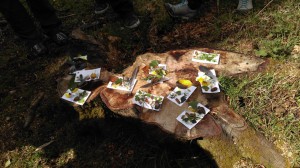
Colour cards – 2 rows double sided sticky tape on a card, ‘pick & stick’ as many cool/colourful things as you want. Simple, but very fun!
I’ve been getting more involved with community events – one in particular was a ‘Food for Thought’ event ran by Ballymoney Borough Council, which was based around the tasty area of food – growers, allotment community groups, food bank volunteers, schools, etc. It was a great event for networking and chatting to people – especially a map of the area, where everyone was invited to write down what was going on in their area. I’m looking forward to going to more of these type of events throughout the year ahead.
Whilst there I spoke to members of Lint Dam Allotments Community Group – a few weeks after that, I went down to the site, where they’ve achieved an awful lot in the 2 years their project has been running! One of their main problems is acquiring funding, so I’m currently doing a fundraising search to see what I can point in their direction. Their small allotment backs onto a field which they would like to purchase in order to expand the allotment and give more people in their community a chance to grow their own food, so I’m specifically looking into this area.
Another attendee of the ‘Food for Thought’ event were some representatives from Ballymoney Model Controlled Integrated Primary School. Prior to this event, they had asked us to come down to do a site visit with them, to advise on how they could improve their large school grounds for both wildlife and outdoor education. We had a great time at the site visit – they have stacks of potential for improvement projects on their land. After our site visit, I drew up extensive plans and costings for them. I know I keep talking about the Eco-Schools project (see my last blog post), but it has really helped teachers’ understanding of the outside as a potential classroom, and the importance of improving their lands as a way of teaching children about how our environment is linked together and dependent upon those connections.
A potential chance I will have of linking my training to an event will hopefully be happening in the summer. I attended a wildflower seed collection training workshop in Clandeboye Estate, ran by True Harvest Seeds, who are trying to establish an Irish collection of wildflower seeds on the island itself. We all committed to collecting one (or two) species from our local area to contribute to the collection, which is ran in partnership with Kew Gardens in England. This will involve training on how to collect the seeds later in the year. This I will hopefully be able to use with one of the schools at which we recently completed a project. St. Mary’s Primary School in Portglenone asked us to create a small wildflower meadow in part of their school garden. The kids all came out in classes throughout one of the days we were there and took part in creating the meadow – from sowing wildflower seeds, to digging holes and planting butterfly-attractive shrubs. As long as the meadow takes (fingers crossed!), then I should be able to go out to the school in late summer/autumn, show them how to collect seeds from their meadow. This will then mean they can self-seed their meadow to maintain it, and even give seeds away to friends/parents/relatives, and spread the wildflower goodness a bit further!
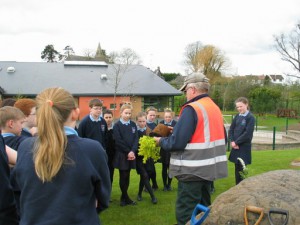
Some of the older classes helped us plant fragrant and nectar-rich shrubs around the garden to encourage moths, butterflies & bees in.
We were back at Rea’s Wood on Lough Neagh in Antrim in March, doing some litter picking (in horrendous weather, our poor hardy volunteers and myself nearly got blown away!) on the site. I also visited again with representatives from the Forestry Service, the Department of the Environment (DOENI) and some TCV colleagues from the Coleraine and Belfast offices. This was primarily so that all stakeholders for the site could have a clear idea of what we intended to do on the site, and what our funding covers. DOENI, who have responsibility for management of the ASSI section of land were able to point us in the direction of which areas they felt most needed work, and which invasive non-native species were of most concern. I’ve now drawn up a draft management plan of what work we’ll be doing (this is needed for an application for a license to work in an ASSI) and I’m just waiting on feedback to redraft it if needed.
And finally (again, sorry for such a long post, but there’s such a lot of fun stuff going on that I want to tell everyone about!), the Coleraine office completed a tree planting day in Coleraine, sponsored by Northern Ireland Electricity (NIE). This kind of scheme is funded by NIE as a kind of ‘payback’ for trees that they have to fell in their maintenance works around electricity lines – although they fund planting many more than they fell! We planted over 650 native trees in 2 locations in Coleraine – one in a wooded belt linking Somerset Forest with the wider countryside (a really valuable wildlife corridor) and the other in Christie Park on the shores of the River Bann in the middle of Coleraine. A local school (and I mean local, 2 minute walk from the park!) came and helped us plant trees in Christie Park. Representatives from the Local Parks Authority, Coleraine Borough Council, NIE all came down, and even the mayor! It was a really fun day, and although the weather was a little iffy it meant lots of worms were popping their heads up out of the soil, which the kids loved.
I’d also just like to touch on news that has been affecting a lot of us in Northern Ireland who work in the environmental sector – it’s a bit of a sombre note to end on, but particularly relevant for us lot ‘over the pond’. While we knew it was coming, a lot of the government funding cuts for the environmental and voluntary sector have been quite shocking in their severity – both Ulster Wildlife Trust and Belfast Hills Partnership have lost all their funding; Mourne Heritage Trust & Northern Ireland Environment Link (the umbrella body for environmental organisations in NI) have had their funding slashed to a quarter or less than a quarter of their previous funding level. TCV Northern Ireland has lost its funding for three major landscape projects that we deliver across the province. This means that these organisations will find it very hard to maintain their properties/land at the level they have been maintained, and jeopardises access to ‘match funding’ from areas such as the Big Lottery Fund, Heritage Lottery Fund and some EU funding, which requires half of the funding to be secured already. The government’s Department of Environment is facing big cuts of its’ own, they haven’t just passed it on to the NGOs. It’s a bit of an uncertain time as to how severe the effect of these cuts will be on how charities carry out their work, and what effect it will have on the conservation of some of Northern Ireland’s most beautiful and important sites, the full extent of which we may not see until some years down the line. What it certainly does is make the work that we do even more important and relevant for safeguarding the future of NI’s green places and spaces.
For more about the John Muir Award, visit: https://www.jmt.org/jmaward-home.asp
For more information on the budget cuts for environmental non-governmental organisations, visit http://www.bbc.co.uk/news/uk-northern-ireland-32068180 and http://www.tcv.org.uk/northernireland/news/budget-threatens-tear-heart-out-environment
For information on the budget cuts affecting TCV NI, go to http://www.tcv.org.uk/northernireland/news/environment-budget-cuts-northern-ireland
